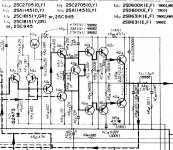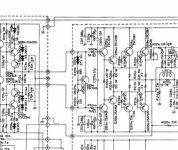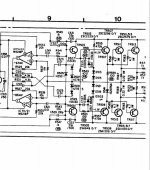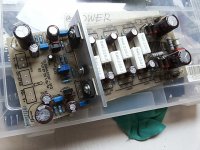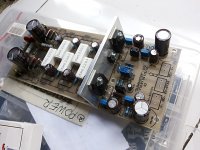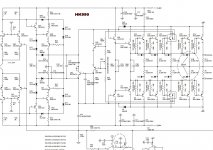Bob Cordell ... in the "troubles with triples" thread , hinted at this.
I took it as good advice , but had to further "play".
Using a real low Cob fast predriver 1381/3503 resulted in the most unstable triple.
It could be made to run on some IPS's by including it in a highly compensated FB loop.
My HK uses 50mhz predrivers , 70mhz sa1837/sc4793 (toshiba) , and slower
sanken OP's. Any fast predrivers I've seen on OEM's shunt C-B to make the 2'nd
stage (main drivers) fastest.
In simulation MJE340/350 or mpsa42/92 as predriver seem to make for EF2 like stability
while attaching all these varied input stages.
Of these combo's for BJT's ... mpsa92/42 - mje15032/33 - MJL21193/4
makes for the perfect current magnifier.
My mje340/350 - njw0281/0302 - njw0281/0302 is also super stable.
OS
I use as predrivers 2SC2240/2SA970 100MHz 3pF Cob, drivers MJE15034/MJE15035, and output are ThermalTrack devices. This amp is in daily use with no stability problem, schematic here: http://www.diyaudio.com/forums/solid-state/182554-thermaltrak-tmc-amp-15.html#post3065943. It is not so hard to stabilize the TRIPLE.
I use as predrivers 2SC2240/2SA970 100MHz 3pF Cob, drivers MJE15034/MJE15035, and output are ThermalTrack devices. This amp is in daily use with no stability problem, schematic here: http://www.diyaudio.com/forums/solid-state/182554-thermaltrak-tmc-amp-15.html#post3065943. It is not so hard to stabilize the TRIPLE.
I uses RC on driver like your amp, Dadod.
Last edited:
OS wrote "Using a real low Cob fast predriver 1381/3503 resulted in the most unstable triple.
It could be made to run on some IPS's by including it in a highly compensated FB loop."
I had a bit more luck - I used 1381/3503 on my e-Amp triple without problems. In that design I did decouple carefully and include base and collector stoppers on the pre-drivers, drivers and OP devices. I guess the take away point here is triples need to be handled with care.
I have taken the decision not to use these as pre-drivers moving forward simply because they are getting difficult to get and will stick with the MJE340/350 - the pre-dirvers do not need to be as fast as the TIS devices.

(NB - its cascodes that can also be a problem - base stopper absolutely needed - had mine going along at 180 MHz - 2N5550/5551 :0 )
It could be made to run on some IPS's by including it in a highly compensated FB loop."
I had a bit more luck - I used 1381/3503 on my e-Amp triple without problems. In that design I did decouple carefully and include base and collector stoppers on the pre-drivers, drivers and OP devices. I guess the take away point here is triples need to be handled with care.
I have taken the decision not to use these as pre-drivers moving forward simply because they are getting difficult to get and will stick with the MJE340/350 - the pre-dirvers do not need to be as fast as the TIS devices.
(NB - its cascodes that can also be a problem - base stopper absolutely needed - had mine going along at 180 MHz - 2N5550/5551 :0 )
Last edited:
I was just going to say something similar.... the quality of the C on semiconductors is pretty bad and a source of a lot of distortion. BUT, if you added quality C externally to a very low C transistor, the results can be better controlled and no increase in distortion.
Thx-RNMarsh
Thx-RNMarsh
OS wrote "Using a real low Cob fast predriver 1381/3503 resulted in the most unstable triple.
It could be made to run on some IPS's by including it in a highly compensated FB loop."
I had a bit more luck - I used 1381/3503 on my e-Amp triple without problems. In that design I did decouple carefully and include base and collector stoppers on the pre-drivers, drivers and OP devices. I guess the take away point here is triples need to be handled with care.
I have taken the decision not to use these as pre-drivers moving forward simply because they are getting difficult to get and will stick with the MJE340/350 - the pre-dirvers do not need to be as fast as the TIS devices.
(NB - its cascodes that can also be a problem - base stopper absolutely needed - had mine going along at 180 MHz - 2N5550/5551 :0 )
In ALL the 100+ OEM EF3's in my "collection" , the ones that use a fast
pre-driver always use B-C shunts (33-100p).
Dadod may of had good luck with shunting the driver , but I have never
seen this in my collection of schematics.
By far the most common was the 70mhz toshiba drivers sc4793/sa1837.
"fast/ fast/ fast " would be highly unlikely. Very few of the Sanken OP
lineup are above 50mhz Ft.
(3) examples below - all are "fast - Faster -slow " , all use 22p -33p to
shunt the predrivers ..... all I either own/recapped and are 20-30 YO !
For my slewmaster , I have some fast to-3p sankens for drivers , the
good ol' NJW's for OP and the mje's for predriver. Should be ideal.
OS
Attachments
Very interesting this problem.
Shunting at pre-driver or driver to better?!
I have seen some schematic with triple used shunting at pre-driver, with C or R-C network.
Interesting collection of schematics OS.
On my Ovation 250 amp I used BF471/2, 15032/3 and 21193/4. Base stoppers on the OP devices, and then a heavy snubber of 27 Ohms and 1 nF to GND in the bases of the driver. A bit of an overkill - 220 pF would also have done it ok. But, without the snubber, I could easily get the OPS to oscillate.
The e-Amp uses a network from the base of the driver to its collector, plus a bunch of other stuff - I spent a lot more time optimizing that part of the amp.
With EF2, base stoppers are usually all you need - but for me about 100 W is the upper limit then.
I was just going to say something similar.... the quality of the C on semiconductors is pretty bad and a source of a lot of distortion. BUT, if you added quality C externally to a very low C transistor, the results can be better controlled and no increase in distortion.
Thx-RNMarsh
I think the biggest issue here is probably the change in input capacitance with voltage. When I started getting back into audio again about 12 years ago, an early prototype used IRF240/9240 (part numbering?). Mistakenly, MJE for the VAS. Lots or parasitics at the top of the waveforms near pk-pk OP and if it clipped, stick rail and a real mess as it exited. Move to BF471/2.made a big difference as did the OPS stoppers. Then I moved onto bipolars.
I may revisit the FET thing again. The idea of a 4 or 5 MHz ULGF FET output CFA excites me.
I think the biggest issue here is probably the change in input capacitance with voltage. When I started getting back into audio again about 12 years ago, an early prototype used IRF240/9240 (part numbering?). Mistakenly, MJE for the VAS. Lots or parasitics at the top of the waveforms near pk-pk OP and if it clipped, stick rail and a real mess as it exited. Move to BF471/2.made a big difference as did the OPS stoppers. Then I moved onto bipolars.
I may revisit the FET thing again. The idea of a 4 or 5 MHz ULGF FET output CFA excites me.
Then we can make modular OPS with FET
My progress was slow
Insulate the NJW0281/0302 drivers !!
Driver vbe (if all plastic) might not need a insulator.
looks GOOD !
OS
In ALL the 100+ OEM EF3's in my "collection" , the ones that use a fast
pre-driver always use B-C shunts (33-100p).
OS
I think that it's not really necessary. Check out the Marantz MA9, or PM11, or SM11. No B-C shunt was applied.
Sajti
Yes, Ill post the page reference from Selfs book so everyone can confirm. As CFAs usually uses shunt compensation one could say thats its already built in and the reason one doesnt find any compensation included in the drivers of triples of 99 % of cfa amps.
Confirmed ... this triple can be very stable without the 33p B-C shunts while
simulating a CFA IPS. Hook up a "blameless" , and SW tests will show VERY
HF ringing.
I would suggest leaving the 2 33pF's alone , as one might want to use
many IPS's. Better safe than sorry ...
PS - It could also be a symmetrical/asymmetrical phenomena ... H/K's
990 has no shunts but has ferrite beads and inductors on the
output stage devices.
Edit - Actually , looking more closely ... they shunt with 270p at the VAS.
OS
Attachments
Last edited:
Manso you never commented my use of OIC in combination with weak Miller compensation in my 200W mosfet CFA. No shunt compensation used.
Damir
Damir I did have a look and I downloaded your asc file which looked fine. However you didnt make use of a triple so I wouldnt speculate. Ive never seen or tried the compensation that you used but Ill admit Im very curious whether it will work. I compared to me using shunt on the same asc file, your OIC is better in THD terms. I got best of 0.0046 to your 0.0039 if I remember the numbers correctly now. I could get better with shunt but I kept the phase and gain margins about equal for better comparison. I should mention that the way I use shunt you basically get a two pole response, I showed it in a post in the other thread.
OIC now only needs to be tested on practical amp, it may turn out to be a very good scheme.
Damir I did have a look and I downloaded your asc file which looked fine. However you didnt make use of a triple so I wouldnt speculate. Ive never seen or tried the compensation that you used but Ill admit Im very curious whether it will work. I compared to me using shunt on the same asc file, your OIC is better in THD terms. I got best of 0.0046 to your 0.0039 if I remember the numbers correctly now. I could get better with shunt but I kept the phase and gain margins about equal for better comparison. I should mention that the way I use shunt you basically get a two pole response, I showed it in a post in the other thread.
OIC now only needs to be tested on practical amp, it may turn out to be a very good scheme.
Thanks Manso for reply, please go to GainWire and tell me if you still want the PCB.
- Home
- Amplifiers
- Solid State
- Slewmaster - CFA vs. VFA "Rumble"
